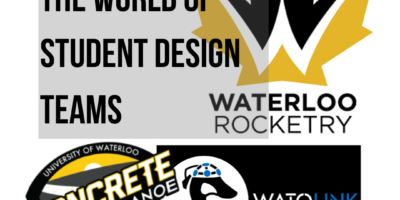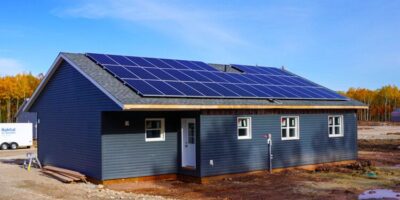I had the pleasure of interviewing Clive Chan from Waterloop. Waterloop is an interesting and innovative design team with ambitous long-term plans, an ideal fit for any student looking to dream big.
What do you do at Waterloop?
Clive: I’m the project manager right now. I have been on the team for four years now. Previously I was technical director. Previously I was software lead. I’ve been around for a while. And I’m currently in my last term.
So, what does Waterloop do as a design team?
The team is dedicated to realizing this concept called Hyperloop. A Hyperloop is a essentially a train inside a tube that is completely pulled down to vacuum, so there’s no air inside of it and you can basically go as fast as you want because there is no air to block you. And so, building this infrastructure across like Canada or the US would be incredibly valuable for both. Number one: the speed or transportation. You can get there faster than a plane because it’s essentially you go to the Hyperloop Station: you can go from Toronto to Montreal in 20 or 25 minutes. There’s also the efficiency benefit, where you’re not being blocked by the air, which is one of the big sources of inefficiency at really high speeds. And that’s why airplanes- you have to go all the way up into layers of atmosphere and then all the way back down and you’re going through the air really fast, so you’re losing a lot of efficiency there. Hopefully this has the potential to be a lot more efficient, and so, a lot more environmentally friendly. So having this transportation architecture would be incredibly valuable. So what our team specifically is doing towards that is we’re number one, building the technologies towards that – that’s involving like the propulsion systems. We aren’t using wheels when we’re traveling at like 700 kilometers an hour because that’s not going to be very maintainable. We’re going to be levitating above the track, so all those technologies there to propel that levitates to stabilize. But also, we’re starting to expand beyond that.
That was the scope of the SpaceX Hyperloop competition, which we’ve previously been participating in, but now we’re sort of branching out beyond that and also developing new concepts for the track itself.
We’re going to build 1000 kilometers of it. How are we going to make that a lot cheaper in order to make it economically feasible? Also, where exactly are we going to put it? A big question there. And so that’s the track side of things.
And then of course we want to build a sort of support for the concept because any huge infrastructure project needs a lot of government support a lot of and a lot support from from the citizens.
We are creating the Canadian Hyperloop competition and so that’s going to be – not sure exactly when yet because Covid – but like something like around a year from now or minus. And we’re going to be inviting a whole bunch of teams too, essentially to do the same thing as the SpaceX Hyperloop competition for the first round, and then perhaps the year after that, we can start adding other elements. Like, how do you design the air pumps? How do you send the tracks? How do you design the entry and exit system from the vacuum tube? How do you design the battery systems, the levitation systems, propulsion systems, all that sort of the whole thing.
Yeah, and that’s that’s sort of the dream for what the team will become in the longer term.
We have this nebulous idea of “Hyperloop 2025”. Well, we want to do a full scale demonstration to the government for some definition of full scale. That’s the goal we’re working towards now. So we’re building up the technical chops and also the financial backing to reach that goal.
Are you saying you’re going to build a train track and train?
Yes, yeah. So, we actually have what we’re in negotiations right now for the location. We’re trying to build a short test track in Waterloo so that we can host this competition. Yeah, no small feat.
What is your favorite part about Waterloop?
I think it’s just the fact that like I’m a software engineer and I don’t really get to touch hardware that often in courses or in jobs, but the fact that it’s such a wide-ranging team so there’s people on the business side who are really, really experts at the social media – putting out really, really incredible media. There’s people on the electrical side who design the circuit boards, who design all these components of communication systems on the pod. There’s people on the mechanical side who are experts in structural analysis, who are able to visualize these 3D things really really well and you just don’t get that kind of breadth in anything other than a full complete project. The team is a complete project just trying to do a physical thing in the physical world and so you need all parts of the stack to be working together. It’s like if you’re employed at a software company, you’re just going to be touching your little corner of software. So, I think it’s a lot more interesting when you have that diversity.
How would you describe the sense of community in your team?
It’s changed quite a bit over the past year just because of the pandemic, but in both cases it’s really been a great support system. It’s been a source of really, really valuable friends.
We just spend a lot of time together because we have to get things done and so of course we make a lot of really valuable friendships that hopefully will stay around for a very long time.
The team is I don’t know how, but like somehow it’s staying really connected, even over the pandemic. People are making efforts to stay connected on Discord or Slack. I mean, just fun calls.
It’s really valuable and really amazing to see.
How have you adapted to being remote with the pandemic?
We were previously only an in-person team. We didn’t even have online meetings whatsoever, so all the off-campus people couldn’t even participate, but we really adapted really well too. Because of the way the pandemic forced us to operate, we have all our meetings online now.
Like every Saturday we’re meeting for like a roughly 5-ish or 4-ish hour long work session and everybody splits into their teams, works on different things with people, pops into other meetings if they need to.
And those meetings throughout the week are also online. And we’ve very recently regained access to the physical base, so we’re sort of trying to speed-run assembly of the pod.
Now we just sort of where we’ve been planning it for the past couple of months, waiting for the inventory. Open and we’re jumping into it and trying to get something done by end of term.
How can new members join?
So every term we hold a sort of just a recruiting drive where we try to specify exact roles.
I think it’s really valuable to have that system where we have this amount of work and we think this is about enough for one person to do for one term. we have those chunks of work planned out ahead of time before we even start recruiting, because if someone joins the team and there’s just nothing to do, it’s sort of a awkward experience and they probably would have been better served joining another team anyway, so we want to make sure we give the best experience possible there, and that requires a bunch of planning ahead of time. But it’s actually proven really valuable from a project management. Perspective as well because we can see this is what we expected to do, and this is where we’re at. and how do we get closer. Are we on schedule etc.
So the way that new members can join each term is we post a lot on social media about the recruiting drive. We post all the roles onto our website. Just follow our social media and you will get all the updates.
Check them out: @team_waterloop




Leave a Reply